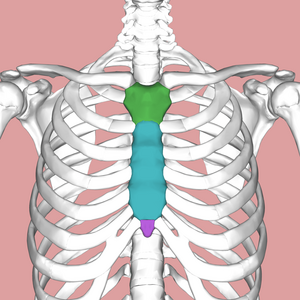Sternum: Difference between revisions
Grace Barla (talk | contribs) No edit summary |
Grace Barla (talk | contribs) No edit summary |
||
| Line 31: | Line 31: | ||
The manubrium makes angle with the body, convex forwards, called as the sternal angle of Louis. certain events take place at this angle - | The manubrium makes angle with the body, convex forwards, called as the sternal angle of Louis. certain events take place at this angle - | ||
# Formation of cardiac plexus | |||
# Upper limit of base of heart | |||
# Arch of aorta starts here as continuation of ascending aorta. | |||
# Arch of aorta ends here to continue as descending thoracic aorta. | |||
# Trachea divides into 2 branches. | |||
# The body | |||
The body | |||
* The body of the sternum is the longest region of the sternum and is roughly rectangular in shape. It is also known as gladiolus | * The body of the sternum is the longest region of the sternum and is roughly rectangular in shape. It is also known as gladiolus | ||
Revision as of 09:30, 20 November 2021
Original Editor - Grace Barla
Top Contributors - Grace Barla, Kim Jackson, Vaibhav Panchal, Lucinda hampton and Vidya Acharya
Description[edit | edit source]
The sternum is a flat cancellous bone with a compact cortex, it is slightly convex anteriorly, with multiple indentations along its lateral borders (costal notches). It forms the anterior median part of the thoracic skeleton. It is commonly known as the breastbone. In shape it resembles like a short sword. The sternum is located along the midline of body in the anterior thoracic region just deep to the skin. It is a flat bone about six inches in length, around an inch wide, and only a fraction of an inch thick. it is longer in males than in females.
Structure[edit | edit source]
The sternum develops as three distinct parts:
- The manubrium
- The body of the sternum
- The xiphoid process
Manubrium
- Manubrium is at the cephalad end of the sternum is the large, flat, wide. At the superior border of the bone there is jugular notch or suprasternal notch. The clavicular notches for the articulation of clavicles are projected upward and laterally on both sides of jugular notch.
- It has two surfaces :
- Anterior surface - It is convex from side to side and concave from above downwards.
- Posterior surface - It is concave and forms the anterior boundary of the superior mediastinum.
Four borders :
- superior border - thick, rounded and concave.
- inferior border - it forms a secondary cartilaginous joint with the body of the sternum.
The manubrium makes angle with the body, convex forwards, called as the sternal angle of Louis. certain events take place at this angle -
- Formation of cardiac plexus
- Upper limit of base of heart
- Arch of aorta starts here as continuation of ascending aorta.
- Arch of aorta ends here to continue as descending thoracic aorta.
- Trachea divides into 2 branches.
- The body
- The body of the sternum is the longest region of the sternum and is roughly rectangular in shape. It is also known as gladiolus
Function[edit | edit source]
Articulations[edit | edit source]
- The anterior surface gives origin on either side to: a. The pectoralis major.
b. The sternal head of the sternocleidomastoid
2. The posterior surface gives origin to: a. The sternohyoid in upper part.
b. The sternothyroid in lower part.
c. The lower half of this surface is related to the arch of the aorta. The upper half is related to the left brachiocephalic vein, the brachiocephalic artery, the left common carotid artery and the left subclavian artery. The lateral portions of the surface are related to the corresponding lung and pleura.
3. The suprasternal notch gives attachment to the lower fibres of the interclavicular ligament, and to the two subdivisions of the investing layer of cervical fascia.
4. The margins of each clavicular notch give attachment to the capsule of the corresponding sternoclavicular.







